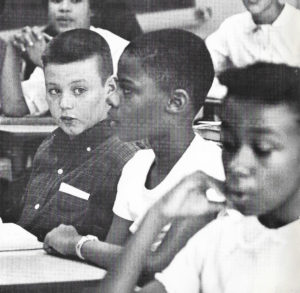St. Joseph’s School in Huntsville, Ala., makes history

When Salvatorian Sisters Ruth Dittman and Bernadette Kline opened St. Joseph’s School in 1956, they began with a simple mission: educate African-American children. They could have hardly known their school would make history just seven years later. In fall of 1963, 12 white students enrolled and attended classes alongside 118 black students. That school year, St. Joseph’s School became the first racially integrated elementary school in the state of Alabama.
Racial tensions were boiling in the South and across the country. Despite Brown v. Board of Education and help from federal law enforcement, the desegregation movement met strong resistance. Yet, in Huntsville, parents voluntarily sent their children to integrate St. Joseph’s School. The school was “reverse integrated,” with white students enrolling in the once all-black school. The process occurred quietly and peacefully, and St. Joseph’s leadership embraced it.
“All we’re doing is teaching religion…to whites, to Negroes, to anybody who comes,” said Father Mark Sterbenz, SDS. As St. Joseph’s pastor at the time, Fr. Sterbenz had a clear and popular message. By December 1963, there were already 25 white students at St. Joseph’s. By 1968, the school’s total enrollment had doubled to 270 students.
Sister Margaret Shekleton, SDS, details this remarkable accomplishment: “What began as a school for black children in a Salvatorian mission parish evolved into a highly respected integrated school, almost unknown in those days.” (Bending in Season: History of the North American Province of the Sisters of the Divine Savior – 1895 to 1985).

St. Joseph’s has undergone many evolutions since it opened its doors in 1963. It began with grades one through four, then grew to include Kindergarten through eighth grade. In 1979, the school merged with nearby St. Mary’s, and became Holy Family School. Throughout the years since its founding, more than 25 Salvatorian Sisters served the school community.
Today, Holy Family School continues the Salvatorian tradition of education rooted in the Gospel. Back in the school’s early years, Fr. Sterbenz spoke to its endurance: “Religion along with education…that’s the reason it works.”




Our 125 Year Celebration
As we look back on our 125th anniversary of coming to the USA, we invite you to reminisce with us. We've launched all 5 time lines with historical milestones and stories that bring to life the experiences of our sisters who came before us.
Era 1: 1895-1920
Responding to Immigrant Needs
The missionary response of hearty immigrant women religious characterizes the first 25 years of Salvatorian Sisters’ presence in the United States ...
Era 2: 1920-1950
Expanding in an “American” Church
By 1920, life for a Salvatorian Sister in the USA was radically different than it had been 25 years earlier. World War I ....
Era 3: 1950-1970
Embracing Renewal
Bob Dylan’s 1964 classic, The Times They Are A Changing, captures the high energy of this era. Change was afoot both outside and inside the Salvatorian convent walls...
Era 4: 1970-2000
Building Collaboration
Events of the mid-1960s renewed the collaborative energy that had always characterized Salvatorian life. Cloistered living ...
Era 5: 2000-2020
Searching for New Footing in a Changing World
When the new millennium arrived on January 1, 2000, Salvatorian Sisters were already five years into our second century on USA soil. Our ...
